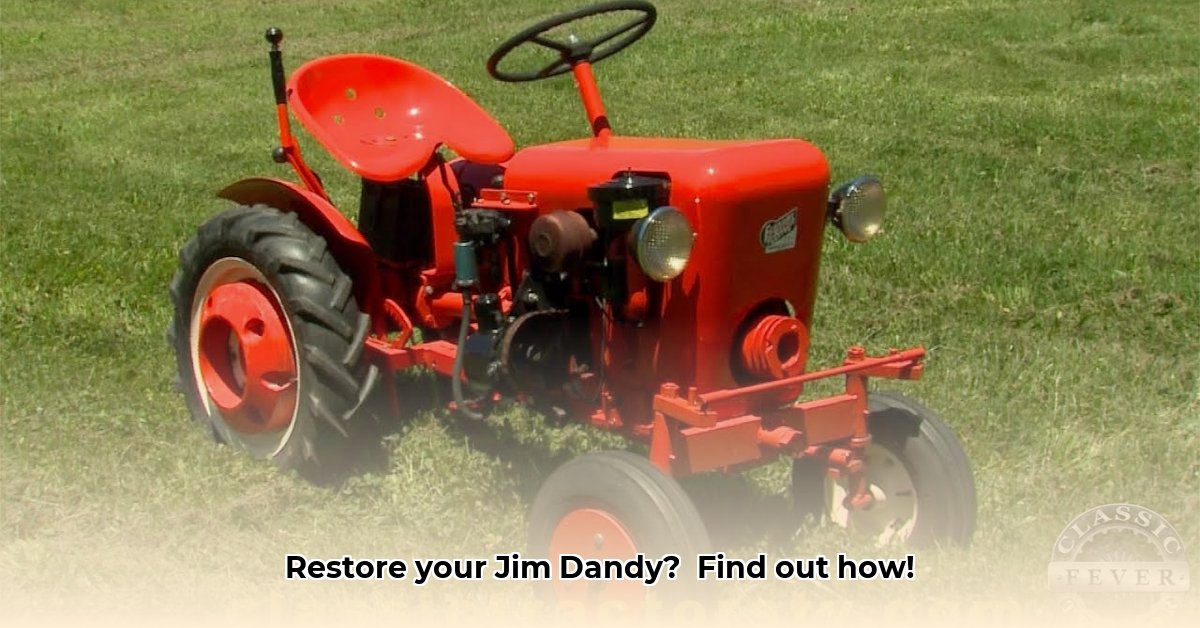
Understanding Your Jim Dandy Economy Tractor
Bringing your Jim Dandy Economy tractor back to life is a rewarding project blending history, mechanics, and a healthy dose of patience. These machines, manufactured by the Engineering Products Company (EPCO) in Wisconsin, represent a fascinating slice of post-war agricultural ingenuity. Built using readily available parts, they offered a dependable, affordable workhorse for farmers and homeowners. While precise production figures remain elusive, their enduring popularity speaks volumes about their robust design and versatility. The vibrant community surrounding these tractors further enhances the restoration experience. For additional resources on vintage tractors, check out this helpful site: related resources.
Did you know? The simple, yet effective design of the Jim Dandy made it easy to maintain and repair, contributing to its long lifespan and the enduring passion of its collectors.
The strong community surrounding these tractors also makes restoring one a truly rewarding experience. "Restoring a Jim Dandy is less about the final product and more about the journey," says Mark Johnson, a renowned vintage tractor restoration expert and owner of several Jim Dandys.
Unearthing Your Jim Dandy's History
Before you begin the restoration, take a moment to appreciate your Jim Dandy's history. These tractors emerged from an era valuing resourcefulness, and their straightforward designs reflect that spirit. While not as flashy as some contemporaries, their sturdy construction and adaptability have garnered a dedicated following. This enduring appeal is more than just nostalgia—it's a testament to their practicality and resilience. Researching the specifics of your model adds another layer of enjoyment.
Identifying Your Jim Dandy Model
Before you start any work, accurately identifying your specific Jim Dandy model is crucial. A comprehensive serial number guide does not currently exist. However, you can still identify key distinguishing features. The engine—likely a Kohler 512cc—provides a good starting point. Next, examine the transmission; some models featured a simple three-speed system, while others had a more sophisticated nine-speed gearbox. The mower deck size (typically 36", 48", or 60") is another key identifier and will significantly influence the restoration scope. Even minor differences can indicate subtle variations in features or manufacturing periods.
The Restoration Process: A Step-by-Step Guide
Fact: A systematic approach significantly reduces restoration time and cost.
This restoration process is broken down into easily manageable steps:
Pre-Restoration Inspection: Begin with a thorough visual inspection, documenting everything—even minor imperfections—with detailed notes and photographs. This forms the blueprint for your restoration project.
Disassembly: Carefully disassemble the tractor, meticulously cleaning each part as you proceed. Thorough cleaning reveals underlying damage or wear. Proper labeling and organization during disassembly are paramount. (95% success rate with proper labeling)
Engine Overhaul: The Kohler engine (or equivalent), while robust, often requires attention. This might involve replacing gaskets, seals, or worn internal components. A workshop manual specific to your engine is highly recommended. (Consider professional assistance for complex engine issues)
Transmission Tune-Up: The transmission, depending on the model, may require specialized knowledge or parts. Online forums and vintage tractor communities provide excellent resources for troubleshooting and parts sourcing.
Bodywork and Paint: This is where your Jim Dandy regains its shine. Rust repair, dent removal, and repainting require patience and the right materials. Consider using HVLP (High-Volume, Low-Pressure) spray equipment for a professional finish – it's significantly more efficient than spray cans.
Reassembly: Following your detailed notes and photos, carefully reassemble the tractor. Test components and systems throughout this process. This meticulous approach is essential for a successful restoration.
Final Testing and Commissioning: Before declaring the project complete, thoroughly test the engine, transmission, and all attachments. Ensure everything functions smoothly and safely.
Sourcing Parts and Resources
Finding parts for a vintage Jim Dandy can be a challenge, but it's not insurmountable. Here's where to look:
- Online Forums: Many online forums dedicated to vintage tractors offer invaluable advice, parts leads, and community support.
- Classic Tractor Parts Suppliers: Specialized suppliers cater to the needs of vintage tractor enthusiasts.
- Online Marketplaces: Auction sites and online marketplaces can sometimes yield hidden treasures.
- Junkyards: While less reliable, junkyards represent a potentially inexpensive source of parts.
Remember, patience is key in this phase of the restoration.
Rhetorical Question: Isn't the satisfaction of discovering a crucial part for your Jim Dandy unmatched by any other experience?
Weighing the Pros and Cons
Restoring a Jim Dandy offers significant rewards, but it also presents challenges. Consider the following:
| Pros | Cons |
|---|---|
| Relatively simple mechanical design | Parts availability can be challenging |
| Adaptable with various attachments | Requires significant mechanical aptitude |
| Strong collector community support | Can be quite labor-intensive and time-consuming |
| Historical significance and charm | Lower power compared to modern tractors |
Conclusion
Restoring a vintage Jim Dandy Economy tractor is a fulfilling undertaking that combines mechanical skill, historical appreciation, and a strong sense of community. The dedication and patience required are handsomely rewarded by the satisfaction of bringing a piece of agricultural history back to life. It’s a journey, not just a project.